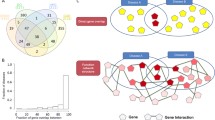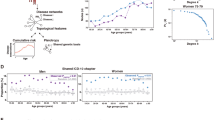Abstract
In this review, the development of ideas focused on the phenomenon of disease combination (comorbidity) in humans is discussed. The genetic bases of the three forms of the phenomenon, comorbidity (syntropias), inverse comorbidity (dystropias), and comorbidity of Mendelian and multifactorial diseases, are analyzed. The results of personal genome-wide association studies of the genetic risk profile that may predispose an individual to cardiovascular disease continuum (CDC), including coronary heart disease, type 2 diabetes, hypertension, and hypercholesterolemia (CDC syntropy), as well as the results of bioinformatic analysis of common genes and the networks of molecular interactions for two (bronchial asthma and pulmonary tuberculosis) diseases rarely found in one patient (dystropy), are presented. The importance of the diseasome and network medicine concepts in the study of comorbidity is emphasized. Promising areas in genomic studies of comorbidities for disease classification and the development of personalized medicine are designated.
Similar content being viewed by others
References
Venter, J.C., Multiple personal genomes await, Nature, 2010, vol. 464, pp. 676–677.
Puzyrev, V.P. and Kucher, A.N., Evolutionary ontogenetic aspects of pathogenetics of chronic human diseases, Russ. J. Genet., 2011, vol. 47, no. 12, pp. 1395–1405.
Zhang, X., Bailey, S.D., and Lupien, M., Laying a solid foundation for Manhattan-“setting the functional basis for the post-GWAS era”, TIG, 2014, vol. 30, no. 4, pp. 140–149.
Hindorff, L.A., MacArthur, J., Morales, J., et al., A Catalog of Published Genome-Wide Associations Studies. http://www.genome.gov/gwastudies
Schaub, M.A., Boyle, A.P., Kundaje, A., et al., Linking disease association with regulatory information in human genome, Genome Res., 2012, vol. 22, pp. 1748–1759.
Barabasi, A.-L., Gulbahce, N., and Loscalzo, J., Network medicine: a network-based approach to human disease, Nat. Rev. Genet., 2011, vol. 12, no. 1, pp. 56–68.
Feinstein, A.R., The pre-therapeutic classification of comorbidity in chronic diseases, J. Chronic Dis., 1970, vol. 23, no. 7, pp. 455–468.
Valderas, J.M., Increasing clinical, community and patient-centered health research, J. Comorbidity, 2013, vol. 3, no. 2, pp. 41–44.
Nikolaev, Yu.A., Mitrofanov, I.M., Pospelov, T.I., et al., Comorbidity in modern internal medicine, Byull. Sib. Otd. Russ. Akad. Med. Nauk, 2014, vol. 34, pp. 44–48.
Valderas, J.M., Starfield, B., Sibbald, B., et al., Defining comorbidity: implications for the understanding of health and health services, Ann. Fam. Med., 2009, no. 7, pp. 357–363.
Puzyrev, V.P., Makeeva, O.A., and Freidin, M.B., Syntropy, genetics testing and personalized medicine, Person. Med., 2010, vol. 4, no. 7, pp. 399–405.
Pfaundler, M. and von Seht, L., Über Syntropie von Krankheitszuständen, Z. Kinderheilk., 1921, vol. 30, pp. 298–313.
Rzhetsky, A., Wajngurt, D., Park, N., and Zheng, T., Probing gentic overlag among complex human phenotypes, Proc. Natl. Acad. Sci. U.S.A., 2007, vol. 104, pp. 11694–11699.
Linghu, B., Snitkin, E.S., Hu, Z., et al., Genome-wide prioritization of disease genes and identification of disease-disease association from an integrated human functional linkage network, Genome Biol., 2009, vol. 10, no. 9, R. 91.
Goh, K.I., Cusich, M.E., Vall, D., et al., The human disease network, Proc. Natl. Acad. Sci. U.S.A., 2007, vol. 104, pp. 8685–8690.
Shirinskii, V.S. and Shirinskii, I.V., Comorbid diseases-actual challenge in clinic medicine, Sib. Med. Zh., 2014, vol. 29, no. 1, pp. 7–11.
Fortin, M., Bravo, G., Hudon, C., et al., Prevalence of multimorbidity among adult seen in family practice, Ann. Fam. Med., 2005, no. 3, pp. 223–228.
Vertkin, A.L. and Skotnikov, A.S., The role of chronic allergic inflammation in the pathogenesis of asthma and its rational pharmacotherapy in patients with comorbidities, Lech. Vrach, 2009, no. 4, pp. 61–67.
Bruce, S.G., Riediger, N.D., Zacharias, J.M., and Young, T.K., Obesity and obesity-related comorbidities in Canadian first nation population, Prev. Chronic Dis., 2011, vol. 8, no. 1, pp. 1–8.
Caughey, G.E., Ramsay, E.N., Vitry, A.J., et al., Comorbid chronic disease, discordant impact on mortality in older people: a 14-year longitudinal population study, J. Epidemiol. Community Health, 2010, vol. 64, no. 12, pp. 1036–1042.
Vidal, M., Cusick, M.E., and Barabasi, A.-L., Interactome networks and human disease, Cell, 2011, vol. 144, pp. 986–998.
Piro, R.M., Network medicine: linking disorders, Hum. Genet., 2012, vol. 131, pp. 1811–1820.
Hurler, G., Über einen Typ multipler Abartungen, vorwiegend am Skelettsystem, Z. Kinderheilk., 1919, vol. 24, pp. 220–224.
Puzyrev, V.P. and Freidin, M.B., Genetic view on the phenomenon of combined diseases in man, Acta Nat., 2009, vol. 3, pp. 52–57.
Dzau, V.J., Autman, E.M., Black, H.R., et al., The Cardiovascular Disease continuum validated: clinical abidance of improved patient outcomes. Part I: pathophysiology and clinical trial evidence (risk factors through stable coronary artery disease), Circulation, 2006, vol. 114, pp. 2850–2870.
Cookson, W., The immunogenetics of asthma and eczema: a new focus on the epithelium, Nat. Rev. Immunol., 2004, vol. 4, pp. 978–988.
Zhernakova, A., van Diemen, C.C., and Wiymenda, C., Detecting shared pathogenesis from shared genetics of immune-related diseases, Nat. Rev. Genet., 2009, vol. 10, no. 1, pp. 43–55.
Doolan, A., Donaghue, K., Fairchild, J., et al., Use of HLA typing in diagnosing celiac disease in patients with type 1 diabetes, Diabetes Care, 2005, vol. 28, pp. 806–809.
Harvey, M., Bellean, P., and Barden, N., Gene interactions in depression: pathways out of darkness, Trends Genet., 2007, vol. 23, pp. 547–556.
Lee, D.S., Park, K.A., Christakis, Z.H., and Barabasi, A.L., The implication of human metabolic network topology for disease comorbidity, Proc. Natl. Acad. Sci. U.S.A., 2008, vol. 105, no. 29, pp. 9880–9885.
Zhang, M., Zhu, Ch., Jacomy, A., et al., The orphan disease networks, Am. J. Hum. Genet., 2011, vol. 88, no. 10, pp. 755–766.
Linghu, B. and DeLisi, Ch., Phenotypic connections in surprising places, Genome Biol., 2010, vol. 11, p. 116.
Tabares-Seisdedos, R. and Valderas, J.M., Inverse comorbidity: the power of paradox in the advancement of science, J. Comorbidity, 2013, vol. 3, pp. 1–3.
Krylov, A.A., On the problem of comorbidity of diseases, Klin. Med., 2000, vol. 78, pp. 56–58.
Ibanez, K., Boullosa, C., Tabares-Seisdedos, R., et al., Molecular evidence for the inverse comorbidity between central nervous system disorders and cancers defected by transcriptomic meta-analyses, PLoS Genet., 2014, vol. 10, no. 2. e1004173
Bragina, E.Yu., Tiys, E.S., Freidin, M.B., et al., Insights into pathophysiology of dystrophy through the analysis of gene networks: an example of bronchial asthma and tuberculosis, Immunogenetics, 2014, vol. 66, nos. 7–8, pp. 457–465.
Demenkov, P., Ivanisenko, T., Kolchanov, N., and Ivanisenko, V., ANDVisio: a new tool for graphic visualization and analysis of literature mined associative gene networks in the ANDSystem, In Silico Biol., 2011, no. 11, pp. 149–161.
Christensen, U., Haagerup, A., Binderup, H.G., et al., Family based association analysis of the IL2 and IL15 genes in allergic disorders, Eur. J. Hum. Genet., 2006, vol. 14, pp. 227–235.
Selvaraj, P., Alagarasu, K., Harishankar, M., et al., Cytokine gene polymorphisms and cytokine levels in pulmonary tuberculosis, Cytokine, 2008, vol. 43, no. 1, pp. 26–33.
Zhang, Y., Zhang, J., Tian, C., et al., The-308 G/A polymorphisms in TNF-α gene is associated with asthma risk: an update by meta-analysis, J. Clin. Immunol., 2011, vol. 31, no. 2, pp. 174–185.
Zheng, X.Y., Guan, W.J., Mao, C., et al., Interleukin-10 promoter 1082/-819/-592 polymorphisms are associated with asthma susceptibility in Asians and atopic asthma: a meta-analysis, Lung, 2013. doi 10.1007/s00408-013-9519-8
Cao, S., Luo, P.F., Li, W., et al., Vitamin D receptor genetic polymorphisms and tuberculosis among Chinese Han ethnic group, Chin. Med. J. 2012, vol. 125, no. 5, pp. 920–925.
Maalmi, H., Sassi, F.H., Berraies, A., et al., Association of vitamin D receptor gene polymorphisms with susceptibility to asthma in Tunisian children: a case control study, Hum. Immunol., 2013, vol. 2, no. 2, pp. 234–240.
Tso, H.W., Lau, Y.L., Tam, C.M., et al., Associations between IL12B polymorphisms and tuberculosis in the Hong Kong Chinese population, J. Infect. Dis., 2004, vol. 190, no. 5, pp. 913–919.
Hirota, T., Suzuki, Y., Hasegawa, K., et al., Functional haplotypes of IL-12B are associated with childhood atopic asthma, J. Allergy Clin. Immunol., 2005, vol. 116, no. 4, pp. 789–795.
Blair, D.R., Lyttle, Ch.S., Mortensen, J.M., et al., A nondegenerative code of deleterious variant in Mendelian loci contributes to complex disease risk, Cell, 2013, vol. 155, pp. 70–80.
Jin, W., Qin, P., Jin, L., and Xu, S., A systematic characterization of genes underlying both complex and Mendelian diseases, Hum. Mol. Genet., 2012, vol. 21, no. 7, pp. 1611–1624.
Ashwood, P., Nguyen, D.V., Hessl, D., et al., Plasma cytokine profiles in Fragile X subjects: is there a role for cytokines in the pathogenesis?, Brain Behav. Immun., 2010, vol. 24, pp. 898–902.
Kirwan, M. and Dokal, I., Diskeratosis congenital, stem cells and telomeres, Biochim. Biophys. Acta, 2009, no. 1792, pp. 371–379.
Huang, F.W., Hodis, E., Xu, M.J., et al., Highly recurrent TERT promoter mutation in human melanoma, Science, 2013, no. 339, pp. 957–959.
O’Roak, B.J., Deriziotis, P., Lee, C., et al., Exome sequencing in sporadic autism spectrum disorders identifies severe de novo mutations, Nat. Genet., 2011, vol. 43, pp. 585–589.
Yu, T.W., Chahrour, M.H., Coulter, M.E., et al., Using whole-exame sequencing to identify inherited causes of autism, Neuron, 2013, vol. 77, pp. 259–273.
Lupski, J.R., Belmont, J.W., Bocrwinkle, E., and Gibbs, R.A., Clan genomics and the complex architecture of human disease, Cell, 2011, vol. 147, pp. 32–43.
McCary, K.L., Park, T.J., Woods, J.O., et al., Systematic discovery of nonobvious human disease models through orthologous phenotypes, Proc. Natl. Acad. Sci. U.S.A., 2010, vol. 107, no. 14, pp. 6544–6549.
Liu, Y.-Y., Slotine, J.-J., and Barabasi, A.-L., Controllability of complex networks, Nature, 2011, vol. 473, pp. 167–173.
Ledford, H., Drug bests cystic-fibrosis mutation, Nature, 2012, vol. 482, p. 145.
Manolio, T.A., Bringin genome-wide association findings into clinical use, Nat. Rev. Genet., 2013, vol. 4, no. 8, pp. 549–558.
Przytycka, T.M., Singh, M., and Slonim, D.K., Toward the dynamic interactome: it’s about time, Brief. Bioinform., 2010, no. 11, pp. 15–19.
Author information
Authors and Affiliations
Corresponding author
Additional information
Original Russian Text © V.P. Puzyrev, 2015, published in Genetika, 2015, Vol. 51, No. 4, pp. 491–502.
Rights and permissions
About this article
Cite this article
Puzyrev, V.P. Genetic bases of human comorbidity. Russ J Genet 51, 408–417 (2015). https://doi.org/10.1134/S1022795415040092
Received:
Accepted:
Published:
Issue Date:
DOI: https://doi.org/10.1134/S1022795415040092




